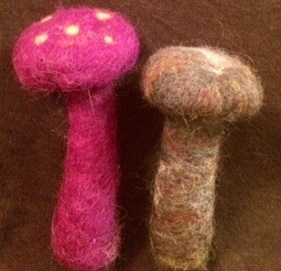
Fiber artist Kaylin Francis returns to the Miller Library this month, virtually, with an online
exhibit of felted mushrooms. From the artist's statement:
Working with fiber has led me on a journey of self-discovery and taking chances. I fell in love with fiber at the age of 12, and that love has continued to grow and evolve over time. It all started with cross-stitch, then moved to needlepoint, then on to making traditional quilts, which led me to making fiber art. All this has led me to earning a BFA in Craft at the Oregon College of Art and Craft, in Portland, Oregon. At OCAC, I added natural and synthetic dyeing, felting, weaving, and screen-printing to my fiber repertoire.
This show, entitled Mushrooms,
came about because of my love of nature and color. Mushrooms are curious and amazing things. There are as many mushrooms as there are colors in the universe.
Observing the forest floor with an artist's eye, she works with wool and dye to depict the colorful and varied fungi that are a hallmark of autumn in the Pacific Northwest and other temperate zones worldwide.